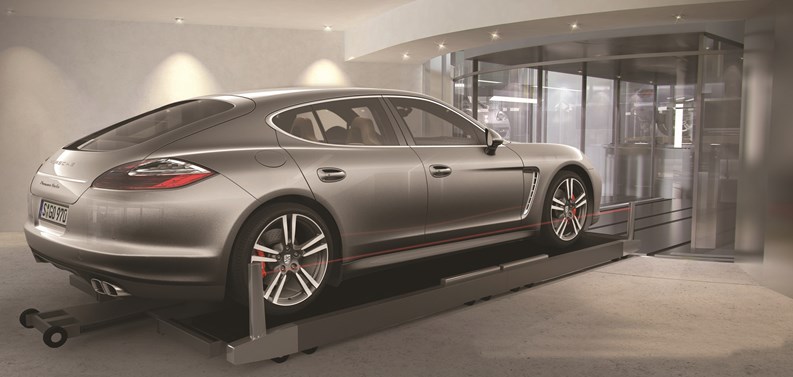Take a gander around major U.S. cities, and you’ll see that the market for newly-constructed condo units is at an all-time high; many developers are seeking way to set their particular luxury properties apart from all the others going up around them.
One amenity that’s been gaining traction in some new construction is the in-unit parking space. It’s exactly what it sounds like: you drive your vehicle onto an elevator platform, hit a button, and you and your auto are spirited up to your apartment. No more endless searching for a spot, no more time wasted on alternate-side parking days, and no more dollars wasted on the inevitable parking tickets.
High-End...Literally
Last summer, a new luxury condo building opened its doors at 200 11th Ave. in New York’s Chelsea neighborhood, and it earned the nickname the “Sky Garage” because it was designed with a car elevator that travels vertically to each residential unit, opening onto an in-unit attached garage. The 19-story condominium with a host of modern amenities is home to actress Nicole Kidman and her husband, country singer Keith Urban and some other well-known celebrities and fashion designers.
“The Sky Garage is a ground up 23-story building of luxury condo units, each unit having a garage with a window in the sky adjacent to the apartment attached by a mud room,” says Steven Kratchman, the architect of the project. “The owner can drive his Range Rover, the SUV chosen as the standard by which the parking facility dimensions should be designed, into the elevator with kids and groceries, and drive into the unit and parking garage. The elevator doors close, and the elevator returns to serve the next client.”
In addition to New York, the robotic parking trend has also taken hold in South Florida. with the Porsche Design Tower Miami in Sunny Isles Beach. Reportedly 60 stories in height, the 132-unit building is slated for completion later this year and promises to be one of the world’s first condominiums in which drivers can sit in their cars as the elevators take them straight to their apartments. The project by Porsche Design Group and developer Gil Dezer is expected to have a total of 284 robotic parking spaces, according to the website of Lucrecia Lindemann, vice president of sales for Dezer Platinum Realty. Other luxury developers around the country are paying attention to the trend, with similar in-unit condos expected to pop up in Chicago and other larger cities in the next few years.
New York-based Automotion Parking Systems LLC has more than 90 automated parking projects worldwide, and offers a system that delivers cars to their owners within two minutes; all without anyone touching the vehicle.
“We manage the technology of robotic parking for apartment buildings and conventional garages,” says Automotion’s chief executive officer Perry Finkelman. “These are high-end, service-oriented garages, a little different than others who try to pack the vehicles in and you have to wait for the attendant to help.”
There are numerous reasons why automated/robotic parking is a growing trend, especially in new condominium construction. The technology allows for the ‘densification’ of vehicles in compact areas that can accommodate more vehicles in the same space or other building amenities with the additional space.
“The shift from building vehicle ramps, large drive aisles, wide parking spaces, taller ceilings, lighting and ventilation for occupied spaces to compact vehicle storage vaults, allows this building type to become more effective and sustainable for its use,” says Ryan Astrup with Park Plus in Fairview, New Jersey. “This adds tremendous value to a project.”
By Design
The trend for automated parking began around 2006, when Finkelman says his company first brought robotic parking to the United States. It is popular in other countries as well, with projects in Europe, the Middle East and Asia.
“All you need to do is pull up and follow the screen directions. You drive into what looks like a private garage area, do what it says and you’re on your way,” he says. “It photographs your vehicle and the condition your vehicle is in when you park it, you go to the kiosk, see the photo and press some safety questions.”
From there, the car is automatically taken to a vault that is out of the way from any other cars or people. When someone wants to retrieve their vehicle, they simply go to the kiosk, swipe their key card, and it’s brought down within two minutes.
“In under a few minutes you can get your vehicle back—and it’s in the exact condition that you parked it. No one has moved the seats, changed the radio or done anything to it,” says Finkelman.
According to Astrup, the loading areas are generally relatively small spaces (not much larger than a single car garage) and located adjacent to building entrances or lobbies, which makes them much safer, easier to monitor and more convenient. They also offer a high level of service without the need for valet, which is a great perk.
“The vault also secures a vehicle from vandalism, accidental damage, or theft,” Astrup says. “Lighting and HVAC is dramatically reduced since this is an unoccupied area, so maintenance costs are reduced in this aspect.”
The technology has improved recently to allow for better functionality through the use of modern devices and developed software. For example, Park Plus manufactures a patented automated guided vehicle (AGV) that uses WiFi-controlled, battery operated shuttles with onboard servers, traffic management software and laser guidance systems to move vehicles stored on trays on flat surfaces.
“This is unlike some traditional automated parking systems that use simple PLC’s (programmable logic controllers), traveling cranes, rails, and open atria that are viewed as hazards by the fire department,” Astrup says. “The AGV system addresses a much safer, structural, and economic approach to automated/robotic parking systems. Multiple devices are used to establish desired throughput cycles and offer redundancy should part of the system need maintenance/repair.”
Challenges Abound
The ability to stay in one’s car, ride up in a large elevator, and drive into a garage adjacent to your residence appeals to those that desire total privacy and minimum effort when leaving or returning to the building, but things aren’t all rosy as a number of U.S. projects have failed or are experiencing problems.
“This concept is a novelty, rather than a strategic effort to make the parking garage a more useful building type,”Astrup says. “The space that an in-unit parking system occupies is not compact since a large elevator shaft extends to all floors and each in-unit parking bay is relatively large compared to a conventional parking space.”
In Miami, for example, robotic parking at BrickellHouse has reportedly been a headache. According to The Real Deal, the condo association at the 374-unit building sued the developer earlier this year and alleged that the robotic parking system operates slowly, with a wait time of over two hours for the unit owners to retrieve their vehicles and that the system would break down at times.
The company that installed the system, Boomerang Systems, based in New Jersey, filed for Chapter 11 bankruptcy, and a bankruptcy judge reportedly cut Boomerang’s contract with developer Harvey Hernandez’s company, Newguard Development Group, last December. Helio de la Torre, an attorney for the condo association, told The Real Deal in August that the association is seeking to replace the system installed by Boomerang with a different version; however, Ronald Lowy, a lawyer who represents Hernandez, said that problem lies within the software that runs the garage.
The cost of the elevator is also much higher since these need to be rated for public use and occupancy. These systems are also restricted to single-use cycles, since only the one elevator can be used at a time—a factor that’s especially problematic when maintenance/repairs are required. At the Sky Garage, another challenge was the zoning restrictions, which disallow parking higher than 23 feet above average curb height or grade.
“Another is having the explosive risk of a full tank of gas in a car adjacent or on the same floor as residential space,” Kratchman says. “Another is carbon monoxide poisoning and noxious gas of a car that might be running while in the garage.”
While pre-calling to get a vehicle might seem like a sound way to get one’s car, when Automotion Parking tried that, people wouldn’t come get their car right away and that held up others from getting their car, hurting the throughput reliability.
Selling the Developer
When developers consider the idea of robotic parking, it’s not that hard of a sell according to the experts. Namely because you can get more cars in a denser footprint, save money and time, and make things more convenient for residents.
“What we tell developers and builders is that robotic parking is a savvy tool because when they come to us in the planning stages, we’re able to help them design a better building, one that is more efficient,” Finkelman says. “We can help them cut some of their construction risk in terms of not building a garage that is deep where you have to go slow because of the excavation.”
On average, there’s a 50-65 percent savings of space using a robotic garage.
“We make sure it’s designed to be reliable, efficiently and safe. Our designs are meant to have the cars come out, with a system that can park out 50 percent of all vehicles in or out within one hour,” Finkelman says. “You have to take into account the functionality and not just try to take in as many cars as you can.”
And if someone is waiting 40 minutes to get their car, that’s a failure in Finkelman’s book.
Final Thoughts
When a building has automated or robotic parking, it’s usually something people like to talk about.
Kratchman doesn’t see in-unit parking to be “taking off” but does believe it’s a way to differentiate condo unit sales in a highly competitive market.
“It gives unique marketing values, product differentiation and unique talking points for brokers to a property and attracts a very special buyer,” he says. “Luxury market condo buyers usually have luxury cars and they often have a special relationship to their cars. Consistent with the trend of consumer demand for privatization of facilities, parking in a public and shared parking facility is not as special as parking in your own garage adjacent to your residential unit and traveling in an elevator up to it.”
“It’s cool technology, it’s safe and reliable and it’s also a very green product since there are no emissions when you park your vehicle as opposed to in a conventional garage,” Finkelman says. “It’s something we see as the future of garages.”
Keith Loria is a freelance writer and a frequent contributor to The Cooperator.







Leave a Comment